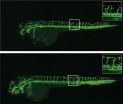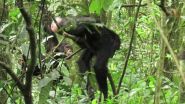(Press-News.org) This news release is available in German.
New methods for modifying the genome are currently widely discussed: Using CRISPR/Cas for instance, scientists can remove parts of the genetic code of a gene, thereby knocking it out. Furthermore, there are ways to inhibit translation of a gene into a protein. Both methods have in common that they impede production of a protein and should therefore have comparable consequences for an organism. However, it has been shown that consequences can differ, after a gene is either knocked, out or only blocked. Scientist from the MPI for Heart and Lung Research in Bad Nauheim now found that additional genes compensate for a knocked out gene and either attenuate consequences or completely compensate deficits. The results suggest caution when interpreting data from molecular biological studies or developing gene therapies to treat various diseases.
To analyse function of an unkown gene, scientists often extinguish the gene and investigate the consequences of this treatment for the organism. To do so, they cut DNA-fragments from the gene using enzymes deleting the genetic information for a functioning protein. Such method is called "Gene knockout". In contrast, in a "gene knockdown" scientists block protein production using particular substances, e.g. microRNAs.
Recent studies, however, have shown that results may vary between knockout- and knockdown animals. Scientists from Didier Stainier's group at the Max Planck Institute for Heart and Lung Research have now identified the reason for this. The Bad Nauheim based researchers have investigated a gene called egfl7 in zebrafish. The gene is involved in the production of connective tissue in blood vessel walls, thereby stabilizing them. Doing so, egfl7 regulates blood vessel growth.
Developmental biologists, however, are not sure, what happens in a fish organism, after the egfl7 gene has been deleted. "If the gene has been blocked in a knockdown, blood vessels do not develop normally", explains Andrea Rossi, together with Zacharias Kontarakis first author of the study. In contrast, if the gene itself is deleted by a genetic manipulation, blood vessel growth is not affected.
In the beginning, Max Planck researchers excluded potential side effects of the knockdown substance being responsible for interference in vascular development. To this end, they injected the substance into fish larvae in which the egfl7 gene had already been deleted. However, the larvae almost developed normally.
"Since the substance did not cause disturbances in blood vessel growth, we thought of a different mechanism: The gene loss could be compensated by another gene taking over the function", Kontarakis says. "Therefore, we were looking for rescue genes, which might have been produced in animals without a functional egfl7 gene."
The researchers compared the mRNA molecules and proteins in fish with or without a functional egfl7 gene and detected several mRNAs and proteins being present in higher amounts in fish without egfl7. An example is emilin 3B. When "knockdown" animals are treated with emilin 3B after egfl7 has been blocked, blood vessels develop almost normally. "This tells us that emilin 3B can compensate for the loss of egfl7. In egfl7 knockout fish, emilin production is getting upregulated. This is not the case in knockdown fish", Stainier explains.
As the next step, the group plans to analyse how genes "know" that another gene has been deleted and then compensate for the loss. Several researchers worldwide are trying to delete disease genes for therapeutic reasons. Before we establish such therapies, we have to fully understand the consequences the loss or blockade of a gene might have. "In addition, our study illustrates the power of comparing knockouts and knockdowns to identify modifier genes, a goal that remains a major challenge in the field of human genetics" says Stainier.
INFORMATION:
Original paper:
Andrea Rossi, Zacharias Kontarakis, Claudia Gerri, Hendrik Nolte, Soraya Hölper, Marcus Krüger & Didier Y. R. Stainier
Genetic compensation induced by deleterious mutations but not gene knockdowns
Nature; 13 July, 2015 (doi:10.1038/nature14580)
Levels of biomarkers in the blood of pregnant women can be used to predict which women are at risk of pre-eclampsia, finds a study published today (22 July) in BJOG: An International Journal of Obstetrics and Gynaecology (BJOG). ADMA and Hcy, both known to be raised in women with pre-eclampsia, are present in the blood in higher than normal concentrations a month before the onset of the condition.
Pre-eclampsia is a combination of raised blood pressure (hypertension) and protein in the urine (proteinuria). It is quite common, usually occurring after 20 weeks of pregnancy, ...
Scientists at Lawson Health Research Institute have uncovered an important new target for ovarian cancer therapy. Contrary to current research this new study found that LKB1, a molecule that regulates the metabolism of many adult cells, is an important molecule in the cancer's promotion and survival.
Thousands of women are living with ovarian cancer in Canada. It is estimated that this year, 2,800 Canadian women will be newly diagnosed with this disease. Even though ovarian cancer continues to be one of the most serious women's cancers, there is a real lack in reliable ...
Patients suffering from chronic cardiopulmonary diseases could soon have a solution to help them accurately monitor their health and warn doctors at the first sign of trouble.
By simply carrying their cellphone, equipped with the health-tracking app, MoveSense, developed by researchers at the University of Illinois at Urbana-Champaign, a patient's oxygen saturation level can be passively monitored with medical accuracy.
Oxygen saturation is a standard measure of health status, the single most important clinical measure. Unlike other methods of measuring oxygen saturation ...
Roughly 20 to 30 percent of patients with hepatitis C virus (HCV) are also infected with human immunodeficiency virus type 1 (HIV). Both blood-borne viruses share the same modes of transmission, but many HCV medications currently have significant limitations due to adverse interactions with HIV treatments. Researchers at University of California, San Diego School of Medicine report a new combination that effectively treats HCV in patients co-infected with HIV.
The study, published online in the New England Journal of Medicine, found the combination of HCV drugs daclatasvir ...
Smokers who successfully lowered their nicotine intake when they were switched to low-nicotine cigarettes were unable to curb their smoking habits in the long term, according to a study by researchers at UCSF and San Francisco General Hospital and Trauma Center.
The study, published online today (July 22) in the journal Addiction found that levels of cotinine, a derivative of nicotine measured in the blood, plummeted six months after smokers' regular cigarettes were replaced with low-nicotine ones. But levels started to rebound later into the study when smokers returned ...
You may have never seen or heard of it, but hair ice - a type of ice that has the shape of fine, silky hairs and resembles white candy floss - is remarkable. It grows on the rotten branches of certain trees when the weather conditions are just right, usually during humid winter nights when the air temperature drops slightly below 0°C. Now, a team of scientists in Germany and Switzerland have identified the missing ingredient that gives hair ice its peculiar shape: the fungus Exidiopsis effusa. The research is published today (22 July) in Biogeosciences, an open access ...
Wealthy people may be likely to oppose redistribution of wealth because they have biased information about how wealthy most people actually are, according to new research published in Psychological Science, a journal of the Association for Psychological Science. The findings indicate that people use their own neighborhoods and communities as a gauge of how much wealth other people possess, leading wealthy people to perceive the broader population as being wealthier than it actually is.
"If you're rich, there's a good chance you know lots of other rich people and relatively ...
New research based on modern techniques suggests that recommendations for protein intake in healthy populations may be incorrect. In a paper just published in Applied Physiology, Nutrition, and Metabolism, an NRC Research Press journal (a division of Canadian Science Publishing), researchers put the focus on protein as an essential component of a healthy diet. Protein helps people stay full longer, preserve muscle mass, and when combined with adequate physical activity, has the potential to serve as a key nutrient for important health outcomes and benefits.
It's not ...
For centuries it has been thought that culture is what distinguishes humans from other animals, but over the past decade this idea has been repeatedly called into question. Cultural variation has been identified in a growing number of species in recent years, ranging from primates to cetaceans. Chimpanzees, our closest living relatives, show the most diverse cultures aside from humans, most notably, in their use of a wide variety of tools.
The method traditionally used to establish the presence of culture in wild animals compares behavioural variation across populations ...
In their struggle to survive and prosper, multicellular organisms rely on a complex network of communication between cells, which in humans are believed to number about 40 trillion. Now, in a study published in Nature Communications, a research group led by scientists from the RIKEN Center for Life Science Technologies (CLST) has published an overall map of how the cells in the human body communicate by systematically analyzing the relationship between ligands--substances such as insulin and interferon that embody messages between cells, and receptors--the proteins on cell ...



